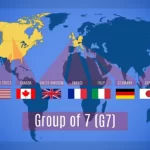Women’s rights are the essence of every country. Its cruciality lies in the fact that a country’s development is directly proportional to the rights enjoyed by women. This is because women are the real actors contributing to the government and household, whether inside or outside the house, driving steady development.
Even the IMF advocates for ensuring better and equal rights for women, which directly impacts the nation’s GDP. For Instance, the losses to an economy from the economic disempowerment of women present surprising results. Estimates range from 10 percent of GDP in advanced economies to more than 30 percent in South Asia and in the Middle East and North Africa.

An empowered woman ensures an empowered family. She’s the one who helps in the growth of a child who turns out as a bright young generation in the future. But, unfortunately, the situation of women in Afghanistan is continuously degrading, possessing a threat to the country’s future.
It has been centuries since Afghan women have been fighting for their rights, making it essential for women to live with dignity. Despite meeting few achievements, it’s still a long for these women, and their real fight starts now under the repressive regime of the Taliban.
WOMEN’S CONDITION: BEFORE TALIBAN RULE
In the early stage, women in Afghanistan enjoyed liberty and exercised every right. Despite being governed under Sharia law Afghanistan was a modern country for Muslim women. For instance, since 1919 Afghan women have had – right to vote, there were even no restrictions on women’s education, movement, and clothing.
Women in Afghanistan were free to do what they actually wanted even child marriage was banned, polygamy was discouraged, and the jurisdiction of religious leaders was narrowed. At that time, women did jobs, ran businesses, and even entered politics.

WOMEN AND THEIR CONDITION UNDER EARLY OCCUPATION OF TALIBAN
During the rule of the Taliban, everyone saw a reversal. In 1979, civil war broke out between communist troops and their opponents.
During that period, brutal laws, regressive policies, and intolerance towards women were rampant. In this period, women were prohibited from almost all education institutions, including school and high schools. Prohibitions were also imposed on working, speaking in public, and even leaving their homes without a male member.
Women were also forced to wear a ‘burqa’. If they refused to follow any of these rules, penalties were imposed for violations, including public lashings and stoning to death.

In another series of curtailments, photographing, displaying pictures of females in newspapers, books, shops, etc., was also banned. Even women’s access to healthcare was also disturbed due to restrictions on their movements. Women were also not allowed to be treated by male doctors unless accompanied by a male.
However in 2001, with the return of democracy women’s rights were restored. In 2004, the Constitution of Afghanistan also ensured women’s representation by securing some seats for women representatives in the Parliament. They also secured some seats in law, government, and media. Furthermore, girls and women’s were allowed to join different professions, including army and police forces. They even received training as surgeons, judges, etc.
WOMEN AND THEIR CONDITION UNDER TALIBAN IN CONTEMPORARY TIMES
Let’s have a look at the contemporary scenario of Afghanistan and the rights of women at present. Through this, we will be able to distinguish the conditions of women at different times.

In August 2021, the Taliban again gained control of Kabul and secured its position over Afghanistan. Soon after entering the office, the Taliban imposed several restrictions on women and girls. Their first dictate was to stop the women from working and remove women from government jobs.
This led to so many problems since many households lost their male family members in the backdrop of continuous war against the Talibani regime. The women members were at the helm of affairs, providing sustenance and looking after their families.
Under the current regime, women are also facing the expansion of the risk of gender-based violence. Constraints on their right to freedom of assembly, freedom of expression, and freedom to move have deprived them of access to justice. For example, the Taliban makes it compulsory for women to go out of the house only when accompanied by a mahram ( male member ).
Families usually do impose restrictions on women’s mobility as a protection measure, instead of establishing a safe environment for women. Therefore, due to these new rules, women’s rights are more violated, and they feel more bounded. It’s just like banning driving vehicles on roads because accidents happen, instead of making the roads safe.

The combination of such restrictions – women’s right to work, sex–segregation at the workplace, mahram requirements, clothing regulations, have resulted in the most regressive form of behaviour against women. This makes it seem all those years of struggle by the women to secure their rights, vanish like a dream.
The lack of the entire presence of women in such humanitarian settings risks erasing or marginalizing women’s contribution and reduces the ability of women beneficiaries to access essential services.
VIOLENCE AGAINST WOMEN IN AFGHANISTAN
Violence against women has been a constant issue in Afghanistan. The violence rate was not suddenly increased after August 2021. Even before the rates of violence against women were extremely high. Some Taliban officials, particularly those who conducted peace negotiations and favoured international engagement, have suggested that this interaction of Taliban governance might be less restrictive toward women.

Although we can see few positive impacts on women’s status under the Taliban regime. For instance, talking about “widows”, they state that widows should not be forced into marriage. Also, they have a share in their husbands’ property.
However, most of their recent decades have been regressive and repressive towards women. Though it’s welcoming that women have been allowed to study, though, in separate classrooms, Afghan women have a long way to go. This was the reason why many prominent women fled from Afghanistan to different countries considering the group’s return to power.
The Taliban also abolished the Ministry of Women’s Affairs. Allocating responsibility to the Ministry building to the reinstated Ministry of Vice and Virtue.
Despite the fact, that the ministry of Vice and Virtue has been previously associated with some of the worst abuses against women during the previous period of the Taliban. It was this ministry that was responsible for developing religious police to enforce Sharia law during the earlier Taliban rule.

SHARIA LAW AND WOMEN RIGHTS UNDER TALIBAN
If we talk about Sharia law in Afghanistan, the Taliban clearly said that the democratic system will not work in Afghanistan, so they will follow Islamic law / Sharia law for their work and women’s rights. They also believe that people fleeing from Afghanistan are not doing it for fear of the Taliban. People are fleeing Afghanistan to escape from Sharia law.
So What is Sharia law? Sharia law is the law established based on the teachings of the Holy Quran which forms the moral and legal framework of Islam. The Quran is a set of details to the path of moral life, but there are no particular laws.
Therefore, we cannot interpret the holy Quran in one specific way. No holy book, No god, No religion talks about repressive measures. It is the people and their interpretation that molds teaching to suit their needs.

To ensure its control and dominance Taliban deprives its women of rights and blames it on Sharia. However, It’s the same Sharia law and teachings of the Holy Quran that grant rights to women in other Islamic nations. This makes us wonder are they less devout Muslims? the answer is a straight NO!
The interpretation of Sharia is a matter element of debate across the Muslim world and governments that bases their legitimate systems on Sharia law. Some people claim that women cannot work and study under this law. Still, one Taliban spokesperson said that women are allowed to work and study. They can even participate in government work if they wish to.
CONCLUSION
Several issues can be traced even before the Taliban rule. This includes honour killing, child marriages, the payment of a bride price, BAAD ( trading of young girls), harassment of women in different places which are still practised in rural areas. So we cannot say that conditions of women were perfect before the Taliban rule.
Still, we can say that the conditions of women before the power of the Taliban were comparatively better. Women could practice freedom of speech and expression, freedom of movement, profession, and even work with a government under Taliban rule.

Women in Afghanistan are currently asking for international help. Not only this, Afghan women are fighting back by coming to the streets and protesting against the Taliban rule, even in the face of violence from the Taliban and attempts to ban protest.
Human rights watch also supports Afghan women and keep a list of Taliban policies that violate women’s rights. I hope that Afghan women will get justice. So they can enjoy their basic fundamental rights and do what they wish to do without fear, like any other woman in other parts of the world.
About the Author:
Komal Chaudhary

Komal is a very passionate girl who loves to explore new things. Currently, she is doing Masters in Political Science from Delhi University. In addition, she has a keen interest in international affairs and effectively pursues the same. As a youth of the contemporary world, she aspires to make the Indian population more conscious and knowledgeable by working with The International Prism.







So well written , properly structured.
Straight to the point, not exaggerating at all.
[…] You may also like this: “The Real Threat”: Women’s Rights In Afghanistan During The Regime Of The Taliban […]
The Author has discussed a very crucial topic here and she has touched all possible arguments, in a well-structured flow. In-depth knowledge in a brief, keep writing more gems. All the best!
[…] Read more about women and their crisis during the Taliban regime here! […]
[…] “The Real Threat”: Women’s Rights In Afghanistan During The Regime Of The Taliban […]